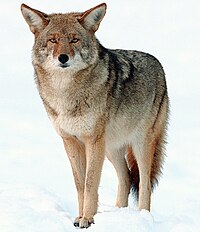
Photo from wikipedia
Abstract Prior to 1900, coyotes (Canis latrans) were restricted to the western and central regions of North America, but by the early 2000s, coyotes became ubiquitous throughout the eastern United… Click to show full abstract
Abstract Prior to 1900, coyotes (Canis latrans) were restricted to the western and central regions of North America, but by the early 2000s, coyotes became ubiquitous throughout the eastern United States. Information regarding morphological and genetic structure of coyote populations in the southeastern United States is limited, and where data exist, they are rarely compared to those from other regions of North America. We assessed geographic patterns in morphology and genetics of coyotes with special consideration of coyotes in the southeastern United States. Mean body mass of coyote populations increased along a west‐to‐east gradient, with southeastern coyotes being intermediate to western and northeastern coyotes. Similarly, principal component analysis of body mass and linear body measurements suggested that southeastern coyotes were intermediate to western and northeastern coyotes in body size but exhibited shorter tails and ears from other populations. Genetic analyses indicated that southeastern coyotes represented a distinct genetic cluster that differentiated strongly from western and northeastern coyotes. We postulate that southeastern coyotes experienced lower immigration from western populations than did northeastern coyotes, and over time, genetically diverged from both western and northeastern populations. Coyotes colonizing eastern North America experienced different selective pressures than did stable populations in the core range, and we offer that the larger body size of eastern coyotes reflects an adaptation that improved dispersal capabilities of individuals in the expanding range.
Journal Title: Ecology and Evolution
Year Published: 2019
Link to full text (if available)
Share on Social Media: Sign Up to like & get
recommendations!